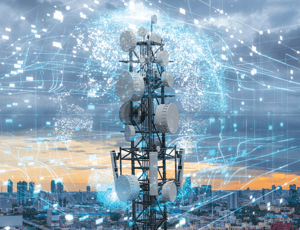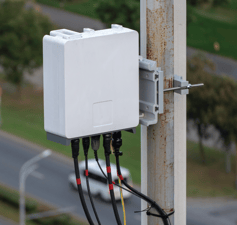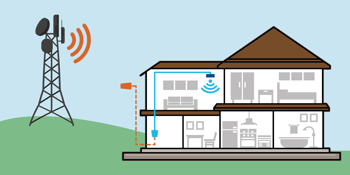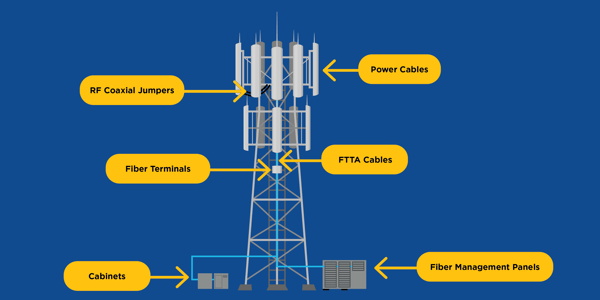
Since its initial deployment in 2018, 5G has ushered in a new digital era, promising unprecedented data speeds, low latency, and enhanced capacity that surpasses anything seen before. Yet, beneath the promises of the fifth generation lies a crucial need – the expansion of wireless networks to match the appetite for connectivity.
Transitioning from 4G to 5G
During the era of 4G, new trends emerged, including the growth of Internet of Things (IoT), an increase in smartphone usage, and the rise of remote and mobile workforces, according to TechTarget. These trends sparked a demand for faster speeds and increased cell density, giving rise to 5G networks. The key differences between 4G and 5G include latency, download speeds, and coverage.
Latency: 5G offers latency under 5 milliseconds, while 4G ranges from 60 to 98 milliseconds.
Download Speeds: 4G’s download speeds hit 1 Gbps, while plans call for 5G to reach maximum speeds of 10 Gbps.
Coverage: 5G high-band connectivity uses millimeter waves, which are shorter in length than 4G wavelengths. Due to its shorter length, 5G can transmit more data than 4G, but it comes with a reduced range of coverage.
Expanding Wireless Networks: Macro Cell vs. Small Cell vs. In-Building
4G depended on macro cells, such as towers, to transmit data. However, 5G’s shorter range increases the need for more wireless sites, prompting the rise of small cell and in-building wireless applications. These newly deployed hubs are positioned closer in proximity between sites to align with the requirements of 5G technology. So, what sets these applications apart?
Macro Cell
Strategically placed and easily identifiable towers are typically located in rural areas along highways, freeways, and suburban neighborhoods. Macro cells provide fast and reliable connectivity to large groups of users across large areas.
 Small Cell
Small Cell
Small cell networks are frequently deployed to boost wireless coverage and capacities in regions experiencing high user demand, such as urban areas, stadiums, and arenas. These networks are deployed closer together and can be seen on streetlights, utility poles, or within stadiums and arenas to increase network capacity in densely populated areas.
In-Building
These wireless networks play a crucial role in ensuring reliable connectivity within structures such as offices, homes, malls, and hospitals. Installing in-building wireless networks within large structures increases speeds for groups of users by providing reliable indoor connectivity for smart devices and services.
Crafting a Network with the Right Solutions
Building a wireless application isn't a one-size-fits-all task, especially considering the diverse size, capacity, speed, and region of each network. To achieve a well-balanced application, it’s crucial to select products that align with the geographical and connectivity needs of each network type. At the forefront of understanding and addressing these diverse needs, Belden and its PPC brand excel in tailoring connectivity solutions for macro cell, small cell, and in-building wireless networks.
Contrary to popular belief, 5G signals do not transfer completely wireless. While components like antennas receive the initial wireless signal, the actual transfer of data occurs through wired products. PPC wired solutions consistently meet the demands of each application by seamlessly transmitting signals from an antenna to a 5G core or central office.
Our experts have crafted wireless components that are critical for exchanging 5G data, including:

- RF Coaxial Jumpers: facilitating connectivity for wireless radios to the antennas, these shielded jumpers create an uninterrupted connection and block outside interference
- Power Cables: delivers power to wireless network equipment, even in the harshest environments
- FTTA (Fiber-to-the-Antenna) Cables: for radio connections, FTTA cables seamlessly transfer data to a fiber terminal
- Fiber Terminals: a transitional point between FTTA cables and fiber trunks, these terminals can also be used for the distribution of fiber in small cell deployments
- Cabinets: 5G cabinets ensure seamless data flow by enclosing the electrical network equipment and connectivity in a controlled environment
- Fiber Management Panels: these panels are housed within 5G cabinets and are the connection point from the wireless site and the core network
Customized for each wireless network, these products stand out for their range in various environments. From the freezing temperatures of the north to the humid air in the south, each environment presents distinct needs to withstand extreme conditions. Dedicated to meeting specific system requirements and enduring extreme weather cycles, we offer connectivity solutions meticulously tested in our R&D lab. Through rigorous testing, each product ensures top-notch wireless connectivity, guaranteeing reliable performance in nearly any weather condition.
Wireless networks are experiencing ongoing expansion boosted by technological advancements. With 5G proliferating, our solutions have demonstrated exceptional adaptability and resilience, making them ideal for various connectivity and environmental challenges. Looking forward to the early 2030s, the rise of 6G is expected, which will once again reshape and dominate the network landscape.


